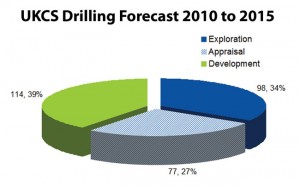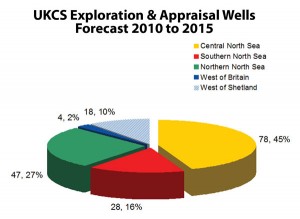UKCS drilling activity projected to stay stable in 2011, though underfunded wells could be damper
By Linda Hsieh, managing editor

As of late September, there had been 55 exploration & appraisal (E&A) well starts on the UK Continental Shelf (UKCS) in 2010, including 41 spuds and 14 sidetracks, according to UK-based research firm Hannon Westwood. That’s compared with a total of 76 E&A well starts in 2009, with 40 spuds and 36 sidetracks. “Already in terms of spuds we’ve exceeded the 2009 levels, and we’ve still got a quarter of the year to go,” said Simon Robertshaw, Hannon Westwood senior intelligence analyst. He expects an additional 10 to 15 wells to start before year-end.
For 2011, Mr Robertshaw expects activity levels to stay broadly in line with 2010, although only 24 wells were actually planned for 2011 as of late September. One difference could be that there might be more exploratory drilling versus appraisal drilling next year. Considering a minimum of 50 spuds in 2011, 30-plus will likely be exploration and 20-plus will be appraisal, he said.
On the rig side, there were 24-25 mobile drilling units operating in the UK sector of the North Sea in late September, 13-16 of which were on E&A wells and nine on development wells. In Northwest Europe, the September snapshot showed 38 semisubmersibles active, representing a 90% utilization rate, and 36 active jackups for an 80% utilization rate.

Those numbers are projected to stay relatively stable through 2011, although there is potential for both segments to grow. “The word out there suggests that the jackup market will actually improve and demand should grow next year. It’s already starting to grow in the UK. I believe the same could be said for semisubs,” Mr Robertshaw said. He also points out that, although jackup dayrates are “way, way down” from their 2008 peaks, drilling in the southern UKCS gas basin is still at a historically low level. That betrays a negative perception of the future direction of natural gas prices. “If you’re concerned about the outlook for the gas price, you might hold off drilling … despite the fact that you can pick up a rig pretty darn cheaply,” he said. Of the 55 E&A well starts as of September, 25% of those were in the gas basin.

The Northern North Sea made up about 15% of those 55 well starts. In this sector, Mr Robertshaw believes that the recent success of the Cladhan sidetrack well – which was an upper Jurassic discovery rather than the middle Jurassic sands more typical of the area – could lead to more exploration nearby. “The discovery has helped to de-risk some of the other activities out there. We could see further drilling on the back of that,” he said.
In the Central North Sea, Nexen Petroleum’s Golden Eagle area and Buzzard discovery will no doubt trigger more drilling in the near term. “Nexen just placed its fourth platform in place on Buzzard. Put that in the UK context. People building four platforms for a field? When did that last happen? The ’70s? … Certainly we’ll see additional activity on the back of Nexen’s success.”
The rest of this year’s well starts have been in either the East Irish Sea area (four wells) or the West of Shetland/Atlantic Margin area (three wells).
“West of Shetland/Atlantic Margin had a slow start, but now a multiwell program is kicking up in there… That particular sector will increase,” Mr Robertshaw said. In his lookahead to 2015, which currently stands at 175 actual planned wells, approximately 10% of them will be in this sector. Because the area still lacks infrastructure and most drilling lies in deepwater, “it has to reach a critical mass … in order to get a sufficient number of discoveries appraised to say that, yes, we can commercialize these,” he said.

The Stena Carron drillship recently moved to the West of Shetland to start what could be a three-well program for Chevron, starting with the Lagavulin prospect. Despite some initial challenges – it was reported in September that Greenpeace activists tried to prevent the vessel from reaching the wellsite by attaching themselves to the anchor and swimming nearby – the Lagavulin well has been spud.
The drillship could also later drill an appraisal well for an existing discovery or drill another exploration prospect for BP. “In the near term, we’re looking at at least four wells in deepwaters off the West of Shetland area,” Mr Robertshaw said.
On the investment side, he believes 2010 will end up with approximately $1 billion put into E&A wells; 2011 could see up to $1.2 billion invested. “There is potential for 2011 to see more investment, provided we can get the funding,” he said. Especially for the lower-tier companies that are exploration-led, they may still struggle to raise cash. Approximately 40% to 45% of Hannon Westwood’s forecasted UKCS E&A wells to 2015 are still underfunded. “We understand there is some private equity funding out there, but it’s difficult.”
